#Samantabhadra
Photo
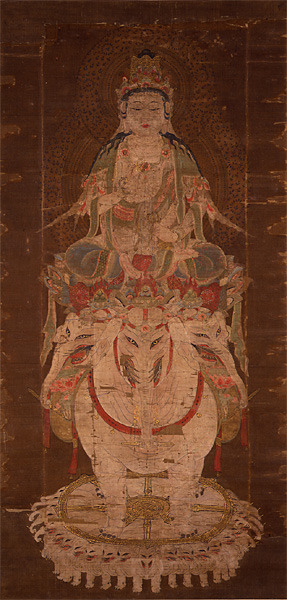
A painted image of Fugen Bodhisattva of Long Life (普賢延命菩薩) dating to the 12th century
Hanging scroll, color on silk from the collection of Matsunoodera Temple (松尾寺) in Maizuru, Kyoto Prefecture
#japanese art#buddhist art#普賢延命菩薩#fugen enmei bosatsu#普賢菩薩#普賢#fugen#fugen enmei#京都府#kyoto prefecture#舞鶴市#maizuru#松尾寺#matsunoodera#真言宗#shingon#samantabhadra
59 notes
·
View notes
Text
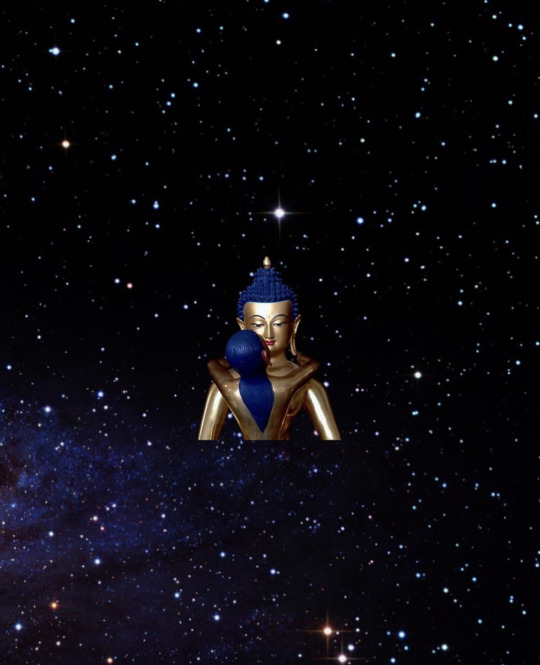
Whenever you engage in any kind of physical or verbal activity, such as eating, lying down, walking, sitting, or going about in the marketplace or among crowds of people, maintain the constant awareness of ascertaining all things as displays of the nonduality of samsara and nirvana, without ever losing the power of this view. Never waver from the state of manifest pristine awareness, devoid of action, in which you retain the confidence of meditation. Abstain from the vices of nonvirtuous actions as if they were poison, never allowing your conduct to slip into carelessness.
Just as the reflections of planets and stars in the ocean are subsumed in the ocean, and just as all the physical worlds and their sentient inhabitants are subsumed in space, so are samsára, nirvana, and the path all subsumed in the one dharmakaya. Experiencing this reality, dwelling in it, entering the womb of the nature of existence, coming to the nature of being within yourself, and ascertaining this to be free of good and bad and of benefit and harm is the experience of realization by which you acquire confidence.
And this is enlightenment.
-Buddha Samantabhadra
#buddha#buddhism#buddhist#dharma#sangha#mahayana#zen#milarepa#tibetan buddhism#thich nhat hanh#Padmasambhava#Guru Rinpoche#Dilgo Khyentse Rinpoche#Samantabhadra#Longchenpa#amitabha
7 notes
·
View notes
Photo
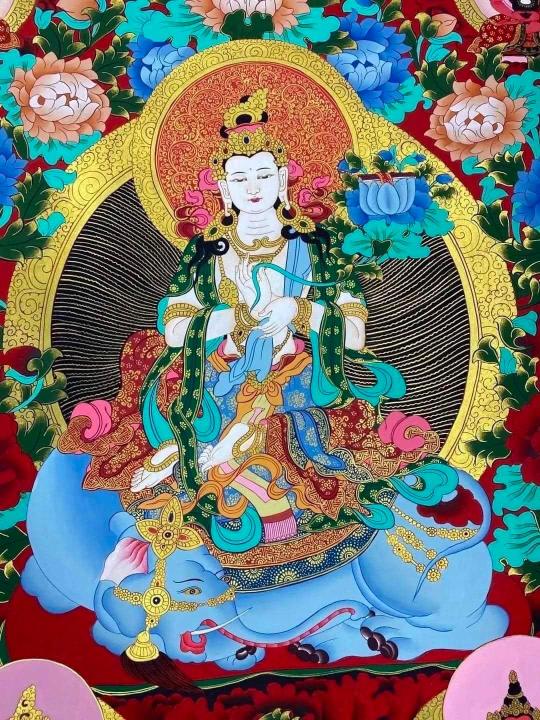
[Thangka art is not signed and the artists, sometimes working alone or sometimes in a small group or school, remain unknown. Some of their work takes years to complete. The staff atop an elephant, it is likely the Bodhisattva Samantabhadra (on many Zen altars, Manjushri and Samantabhadra are to either side of the Buddha)]
[Red Pine (translator) :: Bill Porter (author)]
* * * *
“So what will happen to your consciousness? Your consciousness, yours, not anyone else's. Well, what are you? There's the point. Let's try to find out. What is it about you that you have always known as yourself? What are you conscious of in yourself? Your kidneys? Your liver? Your blood vessels? No. However far back you go in your memory, it is always in some external active manifestation of yourself that you come across your identity—in the work of your hands, in your family, in other people. And now listen carefully. You in others—this is your soul. This is what you are. This is what your consciousness has breathed and lived on and enjoyed throughout your life—your soul, your immortality, your life in others. And what now? You have always been in others and you will remain in others. And what does it mater to you if later on that is called your memory? This will be you—the you that enters the future and becomes a part of it.”
― Boris Pasternak, Dr Zhivago
#Thangka art#Buddhist#Manjushri#Samantabhadra#Red Pine#Bill Porter#Boris Pasternak#consciousness#Dr. Zhivago#quotes#you in others#memory
17 notes
·
View notes
Text
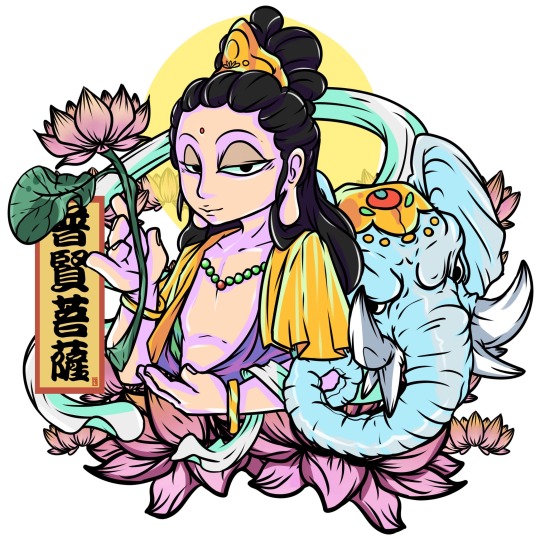
西遊記-
54-Pǔxián Púsà 普賢菩薩
#art#drawing#doodle#fanart#journey to the west#Pǔxián Púsà#普賢菩薩#西遊記#Samantabhadra#100 Journey to the West
14 notes
·
View notes
Photo
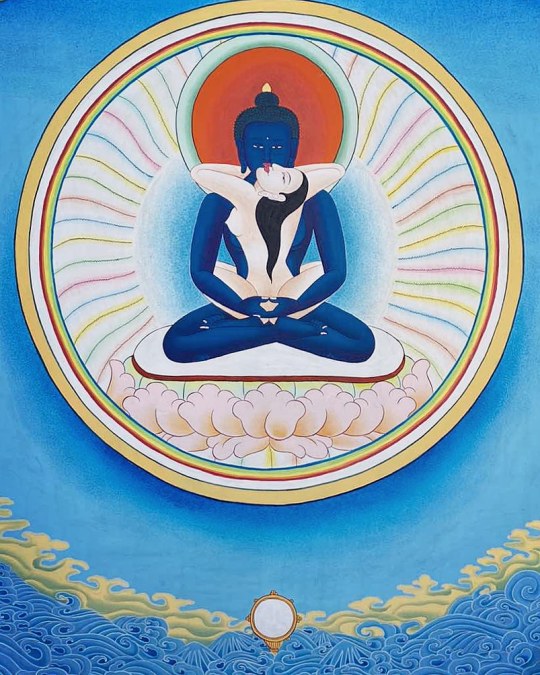
In yoga tantra, highest dimension of Buddhist practice, there is no distinction between gender. In this final life in which you attain Buddhahood, there is no difference whether you are male or female.
~ His Holiness the Dalai Lama
Art: thangka painting of Buddha Samantabhadra in sacred union with Samantabhadri.
241 notes
·
View notes
Text
Blue skin i have fascinating with this whether that's fictional character or a deity or divine being. Specifically like Vishnu and one of he's avatar Krishna from hinduism, buddha aksobhya, buddha samantabhadra one of he's form vajradhara, buddha bhaisajyaguru, bodhisattva vajrapani, bodhisattva akashagarbha, bodhisattva tara in her blue form that's from religion now let's start with fictional character Mystique, raze darkholme, copycat my favorite shapeshifter who have blue skin whether that's light blue or dark blue
#blue skin#buddhism#hinduism#bodhisattva#bodhisattva vajrapani#bodhisattva akasagarbha#buddha bhaisajyaguru#buddha samantabhadra#buddha aksobhya#bodhisattva tara#vishnu#krishna#vajradhara buddha#dark blue#light blue
5 notes
·
View notes
Note
Of the Brotherhood I feel that Wukong and Macaque were the youngest members with DBK being not much older than them. Azure probably was older than DBK but still considered young, same as Peng, and Yellow Tusk very much feels like the eldest of the group but I'm not sure if he'd be considered a full fledged adult by then. At most Azure, Peng, and Tusk would be in the demon equivalent of mid 20s while DBK feels like someone who is 20 year old with Wukong and Macaque at most being between 16 and 18 by demon standards. Those are jsut the vibes I'm getting from the flashbacks
Peng is probably the oldest since the character that they're based on is literally the Buddha's peacock-uncle (long story). Followed by Azure and Yellowtusk being the steads of Bodhisattvas Manjushri and Samantabhadra respectively. Manjushri is described as the oldest of the Bodhisattvas, so Azure is next eldest.
Demon Bull King is about mid, say a freshman college student-age.
And ofc the two Stone Monkeys; Sun Wukong and the Six Eared Macaque - who might as well be too young to drink or drive by demon standards when the Celestial War happened.
Flood Dragon King and the Tamarin King don't appear in the LMK show, so it's hard to determine their age. But I read somewhere that the Flood Dragon King is meant to be the illegitimate son of the Dragon King of the South Sea + a snake demon, so he could be older.
#lmk hcs#lmk the brotherhood#lmk azure lion#lmk yellow tusk elephant#lmk golden winged peng#lmk dbk#demon bull king#sun wukong#six eared macaque#liu er mihou#lmk#lego monkie kid
28 notes
·
View notes
Text
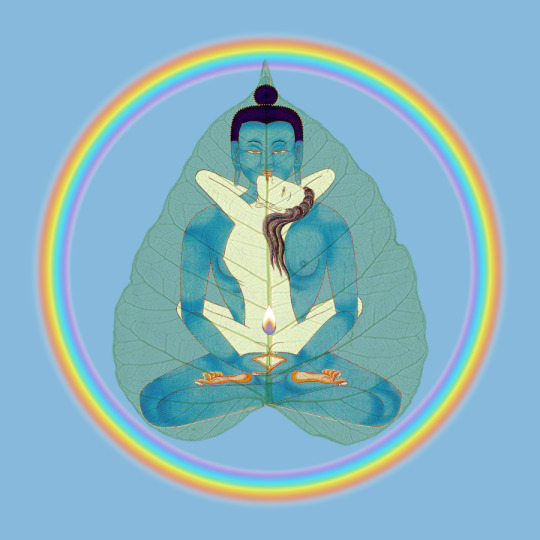
The ultimate Dharma is the realization of the indivisibility of basic space and awareness. That is the starting point, and that is what is pointed out to begin with. It is essential to understand this; otherwise, Samantabhadra and his consort are an old blue man and woman who lived eons ago. It’s not like that at all! Samantabhadra and his consort are the indivisible unity of space and awareness.
~Tulku Urgyen Rinpoche, from his book As It Is, Volume II
Samantabhadra yabyum image from Garchen Rinpoche’s sacred vision, found on garchen.net
71 notes
·
View notes
Photo
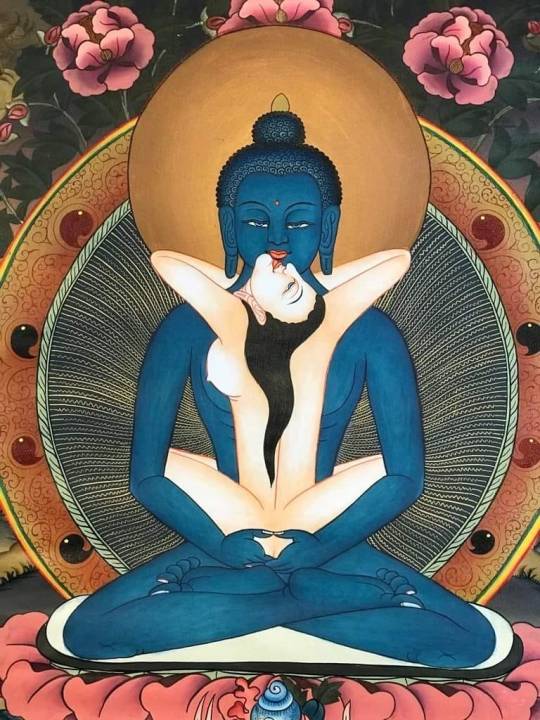

Samantbhadra Buddha
His name Samantabhadra in Sanskrit or Kuntuzangpo in Tibetan, means ‘always good', ‘always well’ or ‘unchanging goodness.’ The significance is that unchanging or fundamental goodness is our ultimate nature.He is pictured in the Yab-Yum (mother-father) sacred embrace with his consortHe is the light blue color of the sky representing the pure state of the mind which is vast and empty, while still including all of existence. She is white, representing pure mental clarity. Together they symbolize the divine union of compassion with wisdom.He is considered a primordial Adi-Buddha, or "first seed of Buddhahood" representing the Dharmakaya (truth body of enlightenment) according to the Nyingma Tradition of Tibetan Buddhism“Samantabhadra is not subject to limits of time, place, or physical conditions. Samantabhadra is not a colored being with two eyes, etc. Samantabhadra is the unity of awareness and emptiness, the unity of appearances and emptiness, the nature of mind, natural clarity with unceasing compassion - that is Samantabhadra from the very beginning”
209 notes
·
View notes
Note
Who are the Twelve Golden Immortals that Taigong keeps mentioning? Are they his superiors?
The Investiture of the Gods has Taigong Wang as the Taoist currently studying under Yuanshi Tianzun and the Twelve Golden Immortals as the 12 disciples who already graduated under Yuanshi Tianzun before Taigong and are full-fledged Xians by the time of the Investiture (the 1100s BC). Not all of them are particularly relevant characters, be it in the actual Investiture or in Houshin Engi.
1) Taiyi Zhenren
About as minor of a character as any of the 12 in the myth, but easily the one with the most screentime in Houshin Engi. Taiyi's main contribution to Taigong's cause was creating the Soul Jewel, which he put inside Li Shi and Li Jing's stillborn baby, allowing Li Nezha to come to life as a living weapon you know from FGO. After Nezha's suicide, Taiyi also arranged Nezha's revival, so he's who FGO blames for Nezha's unfortunate genderbend. Once Nezha is back to life and learns what his father did to his grave, Nezha goes to beat the shit out of his dad, but Taiyi intervenes, capturing Nezha in the Nine-Dragons Divine Fire Basket so he can give him a proper Taoist education and giving Li Jing the means to fight back if Nezha attacks him again (remember that Li Jing is Bishamonten, so the weapon that Taiyi gave him here is actually the pair of towers Kagetora uses on her 3rd Ascension).
2) Yuding Zhenren
Yang Jian's mentor (doubles as Yang Jian's foster father in Houshin Engi). User of the Xian-Slaying Sword. One of the few that gets to be really cool in Houshin Engi but sort of a complete jobber in the original Investiture.
3) Qingxu Daode Zhenjun
Huang Tianhua's mentor. Contrary to Yuding, he's a jobber in the manga but in the myths, he's the one who gets to beat Wang Tianjun, the second-in-command of the Ten Heavenly Lords.
4) Puxian Zhenren
Boddhisattva Samantabhadra's Xian form before he attained Buddhahood. The guy who gets all the homoerotic ship tease with Taigong in Houshin Engi. By Type-Moon's syncretism laws, he's probably the Buddha form of Kouga Saburou.
5) Daoxing Tianzun
Wei Hu's mentor. Comic relief in Houshin Engi. Otherwise irrelevant. Wei Hu himself is pretty irrelevant in the Investiture, but he's known as Skanda in Hindu/Buddhism and is extremely popular in Japan. You might have heard of him before by his Japanese name Idaten.
6) Guang Chengzi
Before being featured in the Investiture of the Gods, this one already had made an appearance in Shenxian Zhuan, where he is portrayed as just a disguise used by Laozi to instruct the Yellow Emperor. But here he's one of Yuanshi Tianzun's apprentices. Does it make sense for Laozi to be Yuanshi Tianzun's pupil? Not much, they should be even-ranked, even if you don't subscribe to the idea that they're the same individual. Maybe it can work if you write him as the first disciple. That said, his combat record fits his possibly Laozi status, having defeated many named enemies including the leader of the Ten Heavenly Lords.
His main role in both the Investiture and its manga counterpart is saving Prince Yin Jiao from Daji by taking him as his Taoist pupil. After training the prince, he lets Jiao return to the world under the condition that he won't betray his mentor to join the war on his father's side. After some tempting words from the villains, Jiao betrays his mentor to join the war on his father's side, so Taigong kills him (what's the best fight in Houshin Engi) but makes him the god of Jupiter under the divine name Taisui Xingjun. Later FGO released Taisui as the cutest event welfare, causing the tragic prince to finally gain Japanese and English Wikipedia pages.
7) Chi Jingzi
The doting mentor of the other rescued prince, Yin Hong. Background character in Houshin Engi but in the Investiture, he gets a decent amount of screentime, which includes a few arcs of invading enemy territory with a lot of powerful Xian treasures, dropping an important one there, needing to invade again to recover the item he forgot there, and then dropping another, rinse repeat. Also when the prince brothers break the promise of not siding with their father in the war, he has a major emotional breakdown and, covered in tears, burns his dear pupil to ashes.
8) Lingbao Dafashi
Actual pack filler. Doesn't do anything notorious in any myth or adaptation. The best I can offer as trivia is that his weapon in Houshin Engi is the Bell of Fallen Souls, which Taisui uses in FGO.
9) Ju Liusun
Buddha Kakusandha's Xian form before he attained Buddhahood. Background jobber in Houshin Engi, but in the Investiture, he wins a major fight and has his own arc about fighting a traitor apprentice but ultimately forgiving and reaccepting his pupil after learning he betrayed because he married a woman on the enemy side. Said redeemed pupil and his wife eventually die anyway in a fight against the same guy who kills Huang Feihu.
10) Wenshu Guangfa Tianzun
Boddhisattva Manjusri's Xian form before he attained Buddhahood. Background jobber in Houshin Engi, and in the Investiture, while he wins a few major fights, he doesn't really get a personal arc. The closest he gets is a small role in Nezha's backstory. It's weird how little Manjusri gets in terms of stories despite being such a popular Boddhisattva.
11) Huanglong Zhenren
If you thought Lingbao Dafashi's situation was dire, you're not prepared for how pitiful Huanglong is. In the Investiture, he's pretty much only there to get his ass kicked by a guy who is not even relevant enough appear in Houshin Engi. In the Houshin Engi manga, he doesn't get a named Paope. In the Houshin Engi artbook, the author gets his name wrong. Dude can't catch a break.
12) Cihang Zhenren
Boddhisattva Avalokitesvara's Xian form before they attained Buddhahood. The same Guanyin that appears as a main character in Journey to the West. The same Kanzeon from the Iori Buddha statues post. They don't do much here outside of some major fights, but that's fine enough when they have so much presence in Journey to the West.
27 notes
·
View notes
Text

Stoicism and Buddhism: A Comparative Analysis
Attraction to those close to you catches you in its currents; Aversion to those who oppose you burns inside; Indifference that ignores what needs to be done is a black hole. Leave your homeland — this is the practice of a Bodhisattva.
Cato hated excess. He hated finery. He hated luxury. He thought to indulge such things was weakness and stupidity. And so what did Cato think of his brother who was far less strict about these things? He loved him. In fact, he worshiped him.
It’s important to remember: The Stoic has strict standards. We have strong opinions on what’s right and what isn’t. But…and this is a big but…we have to be understanding and forgiving of those who have been, as Marcus Aurelius writes, cut off from truth.
Stoicism and Buddhism are two ancient philosophical nd spiritual traditions that have captivated the minds of countless individuals over centuries. While they have distinct cultural origins and historical backgrounds, a closer examination reveals intriguing similarities and differences in their core principles and approaches to life. In this essay, we will explore these two philosophies and shed light on their fundamental ideas, ultimately highlighting the common ground and disparities that define them.
**Stoicism:**
Stoicism, originating in ancient Greece, is a philosophy founded by Zeno of Citium around 300 BCE. It places a significant emphasis on rationality and virtue as the means to attain a tranquil and content life. Several fundamental tenets characterize Stoicism:
1. **Virtue as the Highest Good:** Stoics believe that the highest good is living in accordance with virtue. The four cardinal virtues of wisdom, courage, justice, and temperance are essential in guiding human actions.
2. **Acceptance of What Is Beyond Control:** A core Stoic teaching is the acceptance of things that are beyond one's control. Stoics argue that inner peace is achieved by recognizing and accepting that external events are beyond one's power, while one can control their own thoughts and actions.
3. **Emotional Resilience:** Stoics advocate for emotional resilience through reason and self-discipline. They view destructive emotions, such as anger and fear, as hindrances to a tranquil life and emphasize the importance of maintaining emotional equilibrium.
4. **Detachment from Material Possessions:** Stoicism encourages individuals to detach themselves from material possessions and not be attached to external outcomes or circumstances.
5. **Compassion and Justice:** While Stoics maintain strict standards and opinions about what is right, they also promote the development of a rational and compassionate attitude towards others, placing a strong emphasis on justice and fairness.
**Buddhism:**
Buddhism, founded by Siddhartha Gautama, the Buddha, in ancient India, is both a spiritual and moral philosophy that aims to address the problem of suffering and guide individuals toward enlightenment and liberation from suffering. Buddhism's key principles include:
1. **The Four Noble Truths:** Central to Buddhism is the recognition of suffering as an inherent aspect of human existence. The Four Noble Truths acknowledge the existence of suffering, identify its cause as attachment and desire, propose the possibility of cessation, and outline the Eightfold Path as the means to achieve liberation from suffering.
2. **Detachment from Desires:** Buddhism places a strong emphasis on detachment from desires and attachments as the primary source of suffering. By letting go of attachment to material possessions and craving, individuals can attain a state of equanimity.
3. **Mindfulness and Meditation:** Buddhism teaches the practice of mindfulness and meditation as essential tools for gaining insight into one's own mind and emotions. These practices help individuals transcend attachment to emotions and desires.
4. **Compassion and Loving-Kindness:** Buddhism promotes compassion (karuna) and loving-kindness (metta) as crucial virtues, encouraging the alleviation of suffering not only in oneself but also in all sentient beings.
5. **Karma and Rebirth:** Buddhism emphasizes the concept of karma, which suggests that one's actions have consequences. While Stoicism focuses on the present moment, Buddhism is concerned with the accumulation of good or bad karma, leading to different states of existence in the cycle of birth and death (samsara).
**Comparative Analysis:**
Both Stoicism and Buddhism share some fundamental principles despite their differing cultural origins. Notable points of comparison include:
1. **Emotional Control:** Both philosophies advocate for control over one's emotions. Stoics aim for emotional resilience through reason and self-discipline, while Buddhism teaches mindfulness and meditation to gain insight into and transcend emotions.
2. **Detachment:** Both philosophies emphasize detachment, whether from material possessions (Stoicism) or desires and attachments (Buddhism) as a means to find inner peace.
3. **Compassion:** While Stoics emphasize rational and compassionate attitudes toward others, Buddhism places significant importance on compassion and loving-kindness as virtues to alleviate suffering.
4. **Acceptance:** Stoicism teaches the acceptance of things beyond one's control, whereas Buddhism extends this idea to include the acceptance of the impermanence of all things.
However, they also differ in key ways:
1. **Virtue vs. Enlightenment:** Stoicism centers on the pursuit of virtue and living in accordance with it, while Buddhism is primarily concerned with attaining enlightenment and liberation from the cycle of suffering.
2. **Karma and Rebirth:** Buddhism incorporates the concepts of karma and rebirth, which Stoicism does not address.
3. **The Role of Desire:** Stoicism acknowledges the importance of controlling desires, while Buddhism posits that desires are the root cause of suffering.
**Conclusion:**
In conclusion, Stoicism and Buddhism are two profound philosophical and spiritual traditions that offer valuable insights into human existence, the pursuit of inner peace, and the cultivation of virtues. While they have distinct philosophical and cultural backgrounds, their shared emphasis on emotional control, detachment, and compassion reveals common threads in their teachings. By understanding and appreciating the principles of both Stoicism and Buddhism, individuals can draw upon a broader range of wisdom to navigate the complexities of life, seeking personal growth, self-awareness, and a path toward a more fulfilling and meaningful existence. These philosophies continue to inspire and guide individuals in their quest for a balanced and harmonious life.
#buddha#buddhism#buddhist#dharma#sangha#mahayana#zen#milarepa#tibetan buddhism#thich nhat hanh#stoicism#maha siddha saraha#marcus aurelius#seneca#padmasambhava#inner peace#Guru Rinpoche#Bodhisattva#buddha samantabhadra#Longchenpa#dalai láma#dhamma#dzogchen#four noble truths#green tara#tantra
56 notes
·
View notes
Note
Could you tell us more about fox spirits? or what you know about them? Since the Kitsune is the fox spirit that people popularize the most, information on the Huli Jing is difficult to search for.
*Deep Breath*
Man, oh man. On one hand, I am fascinated by fox spirits, on the other hand, entire books have been written on them (in Chinese), and there are a staggering amount of Qing dynasty fox tales in Yuewei Caotang Biji (阅微草堂笔记) and Liaozhai Zhiyi,(聊斋志异) it's hard to know where to start.
[Previous ask about nine-tailed foxes, the duality of auspicious and demonic, and Su Daji]
Fox spirits, like any other yaoguais, is an animal that has lived long enough and absorbed enough Qi to gain sentience. Through cultivation, they can eventually gain a human form.
According to Tang folklore, they need to wear a human skull on their head while bowing to the Dipper stars/moon, without the skull falling off, in order to transform into a human.
However, foxes are also talented shapeshifters and tricksters who have this reputation for seducing humans, male and female alike.
In earlier legends, that's just their nature, but Ming and Qing tales expanded on that, stating foxes have sex with human to drain their Qi or life force, because they need those to form an Inner Core——an orb of solidified Qi that contains all of their cultivation and life force.
(Usually, it's female foxes seducing human men, because they need some of that sweet, sweet Yang force to compliment their Yin.)
(But some Ming folklore collection said that male foxes also go after guys in the guise of women, while in others, male foxes are just seducers of women.)
(Oh, and there are actual lesbian foxes in Qing legends. Like Feng Sanniang from Liaozhai Zhiyi.)
But one must keep in mind that foxes, like all yaoguais, are not inherently good or evil. For every sexual predator and Daji-like temptress, there exists a graceful scholar, a chill friend, or a lovestruck girl (Liaozhai is full of human-fox romances).
Like, there is a tale in Yuewei Caotang Biji that's just a guy chatting with his 50-60 looking fox associate about how foxes cultivate. When asked why he's so candid about this stuff, he really sums up it best:
"There are good and bad ones among our kind, just like humans. If you humans don't shy away from speaking of human evil, why should I?"
He then proceeds to talk about how legit fox cultivators collect the essence of sun and moon like any regular Daoists, while the ones that seduce human and suck away their life forces are taking a shortcut and inviting heavenly retribution in the form of thunderbolts.
Other Qing legends introduce the hilarious concept that all aspiring foxes must pass an exam organized by the Lady of Mt. Tai, to, well, earn their cultivation permit. Not even foxes are free from the clutches of imperial examinations, it seems!
Still, their old auspicious association does give rise to the archetype of "cultivator/sorcerer foxes", as well as a higher chance of recruitment into the Celestial Bureaucracy.
Which might explain why foxes were so frequently venerated in popular religion. Like, northern China has this thing called the "Five Great Immortals" (五大仙), five species of cultivated animals that people worship:
Hu (胡), Foxes
Huang (黄), Weasels
Bai (白), Hedgehogs
Liu (柳), Snakes
Hui (灰), Rats
When I travelled to the city of Pingyao, Shanxi last summer, one of the sites I visited had a Yuan dynasty building, and its second level is a shrine dedicated to the "Fox Immortal", guardian of the imperial official's seal.
Fun fact: fox spirits have a habit of impersonating Buddhas and Bodhisattvas in Tang dynasty legends. Manjusri and Maitreya seems to be the most popular choice, and in 三遂平妖传, a Ming dynasty novel, "Sagely Old Lady"(圣姑姑) the heavenly fox also impersonates Bodhisattva Samantabhadra.
So imagine my surprise when I actually encountered some foxes next to a highway during the same trip, while visiting Mt. Wutai, Manjusri's sacred mountain!


16 notes
·
View notes
Text
wanna know what made me mad about the final battle in the s4 special
is how like the lmk gang so easily defeated the lion camel ridge trio when it shown last time how they easily kicked their ass (don’t say how MK managed to punch azure multiple times in the celestial realm he caught azure off gaurd )
And I know they had a training montage but one there is like THREE of azure peng and yellowtusk wukong was the only one who was training macaque and nezha were just chilling like they were fucking playing chess
not to mention AZURE IS THE NEW JADE EMPEROR MAKING HIM EXTREMELY POWERFUL NOT TO MENTION wukong in the show WAS DEFEATED BY THE JADE EMPEROR
ALSO THE FACT PENGS THE SWORN UNCLE AND BODYGAURD OF THE BUDDHA
THERE IS ALSO YELLOWTUSK ALSO BEING A BODYGAURD (I know he is a steed in the OG book but this is lmk were it showed them being deities and shit) of bodhisattva Samantabhadra!
SAME GOES TO AZURE he was the bodygaurd of bodhisattva Manjusri
MEANING these guys are really powerful
ALSO in the book azure had tried to overthrown the jade emperor guards tried to stop him he goes to his huge form (yes he could always do that-) AND GOBBLE THEM UP LIKE THEY WERE SNACKS JUST SLURPED THEM UP LIKE NOODLES
and don’t give me the “well azure was trying to hold the world together he was probably weaker-“ MY FRIEND HE STILL KICKED ASS DURING THE FINAL BATTLE it just MK did some corny you made me mad so I’m gonna go super saiyain mood and kick your ass for eye candy and to move the plot to a different direction
azure had also the scrolls! (Cause I know for sure he didn’t have lost all of them AND CANT TELL ME he didn’t go to the underworld himself to collect more just in case! Keep in mind he is the ruler of the three realms now he can have anything his heart desired!)
I know I maybe repeat some info over and over I’m just baffled cause I have a list of reason and there is logic of why azure peng and yellowtusk should have won!
the show and creators (COUGH COUGH AND THE FANS COUGH COUGH) did the lion camel ridge trio so dirty they had so much potential and I hate it cause they are my favorite
#monkie kid#lego monkie kid#lmk azure lion#azure lion#lmk sun wukong#lmk peng#lmk yellow tusk elephant#tw rant#jttw#lmk golden winged peng#monkie kid azure lion#lego azure lion#monkie king#lego monkie king#lego wukong#lmk mk#lmk monkey king#lmk macaque#lmk monkie king#lmk nezha#Lmk#lego monkie kid mk#monkie kid mk#lego monkie kid nezha#lego sun wukong#lego nezha#lego macaque
32 notes
·
View notes
Text
thinking about, bodhisattva Wukong being buddies with Yellow Tusk and Azure Lion, since they are back to being the vehicles of the bodhisattvas Samantabhadra and Manjusri respectfully. so they see each other a lot and hang out :'3
38 notes
·
View notes
Note
What "Bodhisattva" even mean? Are they like a messager or middle man?
They are an enlightened being who foregoes nirvana in order to save countless people from the suffering that keeps man trapped in samsara.
This is the official entry in the Princeton Dictionary of Buddhism (2014):
Bodhisattva (P. bodhisatta; T. byang chub sems dpa’; C. pusa; J. bosatsu; K. posal 菩薩). In Sanskrit, lit. “enlightenment being.” The etymology is uncertain, but the term is typically glossed to mean a “being (SATTVA) intent on achieving enlightenment (BODHI),” viz., a being who has resolved to become a buddha. In the MAINSTREAM BUDDHIST SCHOOLS, the Buddha refers to himself in his many past lifetimes prior to his enlightenment as a bodhisattva; the word is thus generally reserved for the historical Buddha prior to his own enlightenment. In the MAHĀYĀNA traditions, by contrast, a bodhisattva can designate any being who resolves to generate BODHICITTA and follow the vehicle of the bodhisattvas (BODHISATTVAYĀNA) toward the achievement of buddhahood. The Mahāyāna denotation of the term first appears in the AS˙ T˙ ASĀHASRIKĀPRAJÑĀPĀRAMITĀ, considered one of the earliest Mahāyāna sūtras, suggesting that it was already in use in this sense by at least the first century BCE. Schools differ on the precise length and constituent stages of the bodhisattva path (MĀRGA), but generally agree that it encompasses a huge number of lifetimes—according to many presentations, three incalculable eons of time (ASAM˙ KHYEYAKALPA)—during which the bodhisattva develops specific virtues known as perfections (PĀRAMITĀ) and proceeds through a series of stages (BHŪMI). Although all traditions agree that the bodhisattva is motivated by “great compassion” (MAHĀKARUN˙ Ā) to achieve buddhahood as quickly as possible, Western literature often describes the bodhisattva as someone who postpones his enlightenment in order to save all beings from suffering. This description is primarily relevant to the mainstream schools, where an adherent is said to recognize his ability to achieve the enlightenment of an ARHAT more quickly by following the teachings of a buddha, but chooses instead to become a bodhisattva; by choosing this longer course, he perfects himself over many lifetimes in order to achieve the superior enlightenment of a buddha at a point in the far-distant future when the teachings of the preceding buddha have completely disappeared. In the Mahāyāna, the nirvān˙ a of the arhat is disparaged and is regarded as far inferior to buddhahood. Thus, the bodhisattva postpones nothing, instead striving to achieve buddhahood as quickly as possible. In both the mainstream and Mahāyana traditions, the bodhisattva, spending his penultimate lifetime in the TUS˙ ITA heaven, takes his final rebirth in order to become a buddha and restore the dharma to the world. MAITREYA is the bodhisattva who will succeed the dispensation (ŚĀSANA) of the current buddha, GAUTAMA or ŚĀKYAMUNI; he is said to be waiting in the tus˙ ita heaven, until the conditions are right for him to take his final rebirth and become the next buddha in the lineage. In the Mahāyāna tradition, many bodhisattvas are described as having powers that rival or even surpass those of the buddhas themselves, and come to symbolize specific spiritual qualities, such as AVALOKITEŚVARA (the bodhisattva of compassion), MAÑJUŚRĪ (the bodhisattva of wisdom), VAJRAPĀN˙ I (the bodhisattva of power), and SAMANTABHADRA (the bodhisattva of extensive practice). In Western literature, these figures are sometimes referred to as “celestial bodhisattvas.” In Korea, the term posal also designates laywomen residents of monasteries, who assist with the menial chores of cooking, preserving food, doing laundry, etc. These posal are often widows or divorcées, who work for the monastery in exchange for room and board for themselves and their children. The posal will often serve the monastery permanently and end up retiring there as well (Buswell & Lopez, 2014, p. 134).
Also check out the Wikipedia article:
Source:
Buswell, R. E., & Lopez, D. S. (2014). The Princeton Dictionary of Buddhism. Princeton, NJ: Princeton University Press.
39 notes
·
View notes
Photo

There are two ways of seeing everything, the perfect way and the false way, So each and everything that can ever be found holds two natures within. And what does perfect seeing see? It sees the suchness of all things. And false seeing sees the relative truth – this is what the perfect Buddha said.
~ Chandrakirti
43 notes
·
View notes